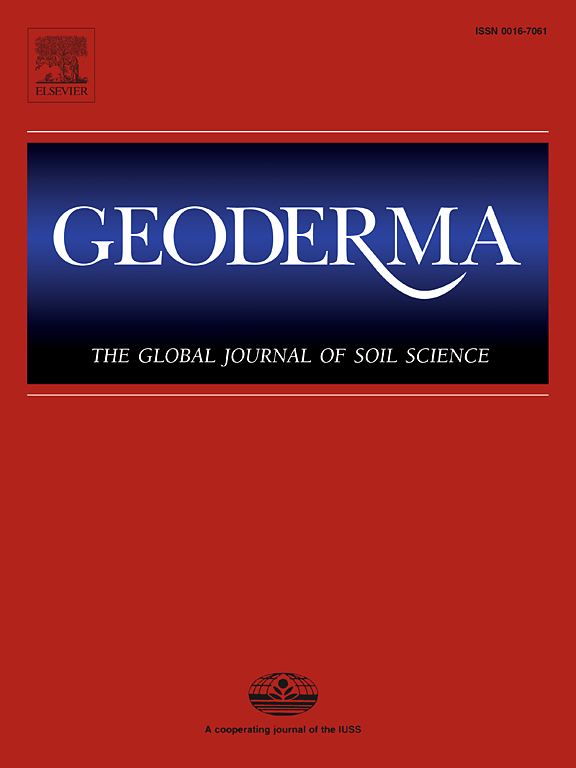长期保护性耕作打破了耕盘,促进了优先流的发展
IF 6.6
1区 农林科学
Q1 SOIL SCIENCE
引用次数: 0
摘要
在农业系统中,大孔隙和优先流对土壤水文功能和生态系统服务起着关键的调节作用。随着全球土壤退化的加剧,特别是常规耕作加剧了土壤板结,保护性耕作(CT)已成为恢复土壤质量的关键策略。然而,CT在缓解土壤压实、调节大孔结构和优先流方面的能力尚不清楚。本研究旨在阐明长期CT如何缓解压实驱动的大孔结构约束和黑土的优先流动。在东北黑土区一块典型的泥壤土(粘壤土、混质土、中质土)上选择了一个18年定位的试验田。x射线计算机断层扫描(25 μm分辨率)和染料示踪技术(1.5 g L−1 Brilliant Blue溶液)用于量化0-50 cm土层中的大孔隙和优先流动路径。采用独立样本t检验(假设方差和正态分布相等)比较两种处理。并进行相关分析以评估变量间的关系。通过结构方程模型进行通径分析,阐明直接和间接影响,并采用CMIN/DF、GFI、RMSEA评价模型拟合。结果表明,CT通过破坏犁盘和优化孔隙结构,有效缓解了土壤压实。与CK相比,CT显著提高了临界10-20 cm层的孔隙度(500-1000 μm) 4.8倍,孔隙连通性提高了21.3倍,孔隙容重降低了9.4%,孔隙扭曲度降低了2.1% (p <;0.05)。值得注意的是,CT生成了延伸至20cm以下的连续孔隙和染色路径,从而减轻了犁盘屏障。这些结构的改进促进了优先流的发展,染料变异系数降低了21.5%,土壤染料覆盖率提高。相关性分析表明,染料覆盖度与土壤理化性质和大孔指数相关性强,特别是500 ~ 1000 μm的大孔指数(p <;0.05)。通径分析进一步证实了CT通过增强宏观孔隙度和降低孔隙弯曲度来控制优先流动模式(p <;0.001)。该研究表明,CT通过破坏犁盘和改善孔隙结构,将压实土重构为水力活性体系,为生态脆弱黑土区防治土壤退化提供了机理见解。本文章由计算机程序翻译,如有差异,请以英文原文为准。
Long-term conservation tillage breaks the plough pan and promotes the development of preferential flow
Macropores and preferential flow critically regulate soil hydrological functions and ecosystem services in agricultural systems. With the intensification of global soil degradation, especially as conventional tillage (CK) exacerbates soil compaction, conservation tillage (CT) has emerged as a crucial strategy for restoring soil quality. However, the ability of CT to alleviate soil compaction and regulate macropore structure and preferential flow remains unclear. This study aimed to clarify how long-term CT alleviates compaction-driven constraints on macropore structure and preferential flow in black soil. We selected an 18-year located experimental field on a typical Phaeozem (clay loam, mixed, mesic) in black soil region of Northeast China. X-ray computed tomography (25 μm resolution) and dye tracer techniques (1.5 g L−1 Brilliant Blue solution) were used to quantify macropores and preferential flow paths in 0–50 cm soil layers. Independent samples t-test (assuming equal variances and normal distributions) was used to compare two treatments. Correlation analysis was also performed to assess variable relationships. Path analysis via structural equation modeling to elucidate direct and indirect effects, and CMIN/DF, GFI, RMSEA were used to evaluate model fit. The results revealed that CT effectively alleviated soil compaction by breaking the plough pan and optimizing pore structure. Compared with CK, CT significantly enhanced macroporosity (500–1000 μm) by 4.8 times and pore connectivity by 21.3 times in the critical 10–20 cm layer, while reducing bulk density by 9.4 % and pore tortuosity by 2.1 % in this layer (p < 0.05). Notably, CT generated continuous pore and staining paths extending below 20 cm, thereby alleviating the plough pan barrier. These structural improvements drove preferential flow development, evidenced by a 21.5 % reduction in dye variation coefficient and enhanced soil dye coverage. Correlation analysis showed dye coverage correlated strongly with soil physicochemical properties and macropore indexes, especially 500–1000 μm macroporosity (p < 0.05). Path analysis further confirmed CT governed preferential flow patterns through macroporosity enhancement and pore tortuosity reduction (p < 0.001). This study demonstrates that CT restructures compacted soil into hydraulically active systems through breaking plough pan and improving pore structure, providing mechanistic insights for combating soil degradation in ecologically vulnerable black soil regions.
求助全文
通过发布文献求助,成功后即可免费获取论文全文。
去求助
来源期刊

Geoderma
农林科学-土壤科学
CiteScore
11.80
自引率
6.60%
发文量
597
审稿时长
58 days
期刊介绍:
Geoderma - the global journal of soil science - welcomes authors, readers and soil research from all parts of the world, encourages worldwide soil studies, and embraces all aspects of soil science and its associated pedagogy. The journal particularly welcomes interdisciplinary work focusing on dynamic soil processes and functions across space and time.
 求助内容:
求助内容: 应助结果提醒方式:
应助结果提醒方式:


